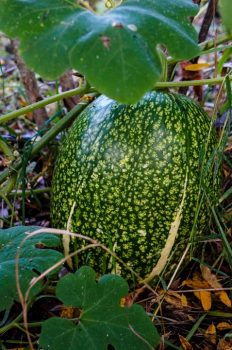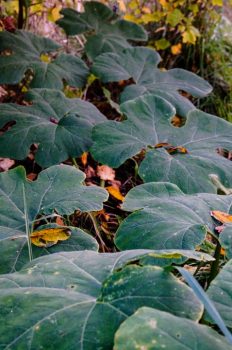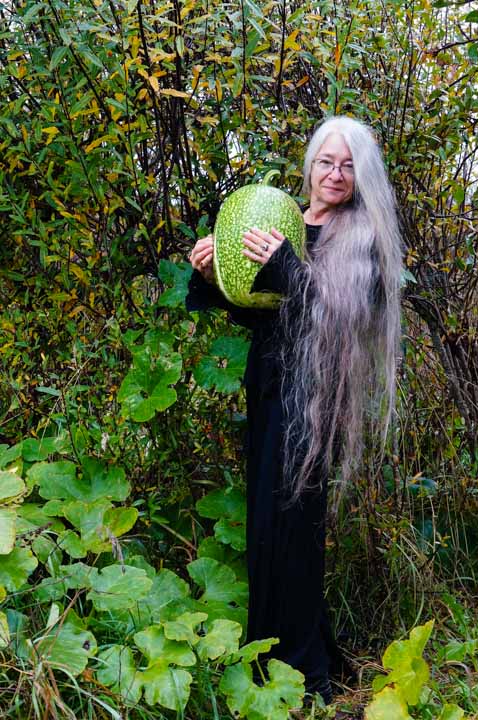Malabar Gourd, Malabar Squash, Fig-Leaf Gourd, Pie Melon
 There are many names for the Cucurbita ficifolia. No matter what you call it, the Malabar is a most amazing squash. It tastes like a summer squash, but the rind gets very hard, and it will keep for 2 years or more. Yes, it looks like a watermelon, and indeed, it contains a lot of water – but the flavor is rather bland, a bit cucumber-like, and it takes on the flavors of the seasonings it is cooked with. Use it for soups, stews, goulashes, stir-frys, pies, and puddings. Personally, I like the melons when they are small, but the big ones are also very meal-worthy. I have read that fermented beverages can be made from the juice; it is also refreshing just plain. The seeds are traditionally candied in Mexico (“palanquetas”). In fact, all parts of the plant are edible; leaves and shoots are tender when they are young. The rinds can be hardened and made into bowls or other containers.
There are many names for the Cucurbita ficifolia. No matter what you call it, the Malabar is a most amazing squash. It tastes like a summer squash, but the rind gets very hard, and it will keep for 2 years or more. Yes, it looks like a watermelon, and indeed, it contains a lot of water – but the flavor is rather bland, a bit cucumber-like, and it takes on the flavors of the seasonings it is cooked with. Use it for soups, stews, goulashes, stir-frys, pies, and puddings. Personally, I like the melons when they are small, but the big ones are also very meal-worthy. I have read that fermented beverages can be made from the juice; it is also refreshing just plain. The seeds are traditionally candied in Mexico (“palanquetas”). In fact, all parts of the plant are edible; leaves and shoots are tender when they are young. The rinds can be hardened and made into bowls or other containers.
How to Grow the Malabar Squash
 Grow this plant like you would any squash. Be aware! It is a climber! One year, it grew up and over the corn, the nearby fence, and around the entire garden! Another year, I trained it up the apple trees, and the fruits hung like giant melons from the branches. The biomass is just incredible. It seems to like partial shade. I have planted the plants in full sun, but the vines seem to seek out the shadier areas of the garden.
Grow this plant like you would any squash. Be aware! It is a climber! One year, it grew up and over the corn, the nearby fence, and around the entire garden! Another year, I trained it up the apple trees, and the fruits hung like giant melons from the branches. The biomass is just incredible. It seems to like partial shade. I have planted the plants in full sun, but the vines seem to seek out the shadier areas of the garden.
The Malabar will die in our northern winters, but I notice that it has survived light frost, especially in areas that are protected by overhanging vegetation, such as in the willow dome and the orchard. They are grown as a perennial in warmer climes.
The seeds continue to mature in the harvested melons and will be black when they are fully ready for planting. I have planted some that are several years old, so they keep their viability fairly well. Be sure to plant extras, as voles and their kin find them attractive when the plants are young.
Harvesting the Malabar Squash
Harvest them any time! Eat the little ones, for sure. Save a big melon or two for the seeds. The fruits easily camouflage beneath the leaves and grasses. It is fun to find a giant one you previously missed! I have read that one plant can grow 50 fruits or more, but I have never achieved anything near that many.
Watch this video to join me on what has become our annual Malabar Squash Hunt!
